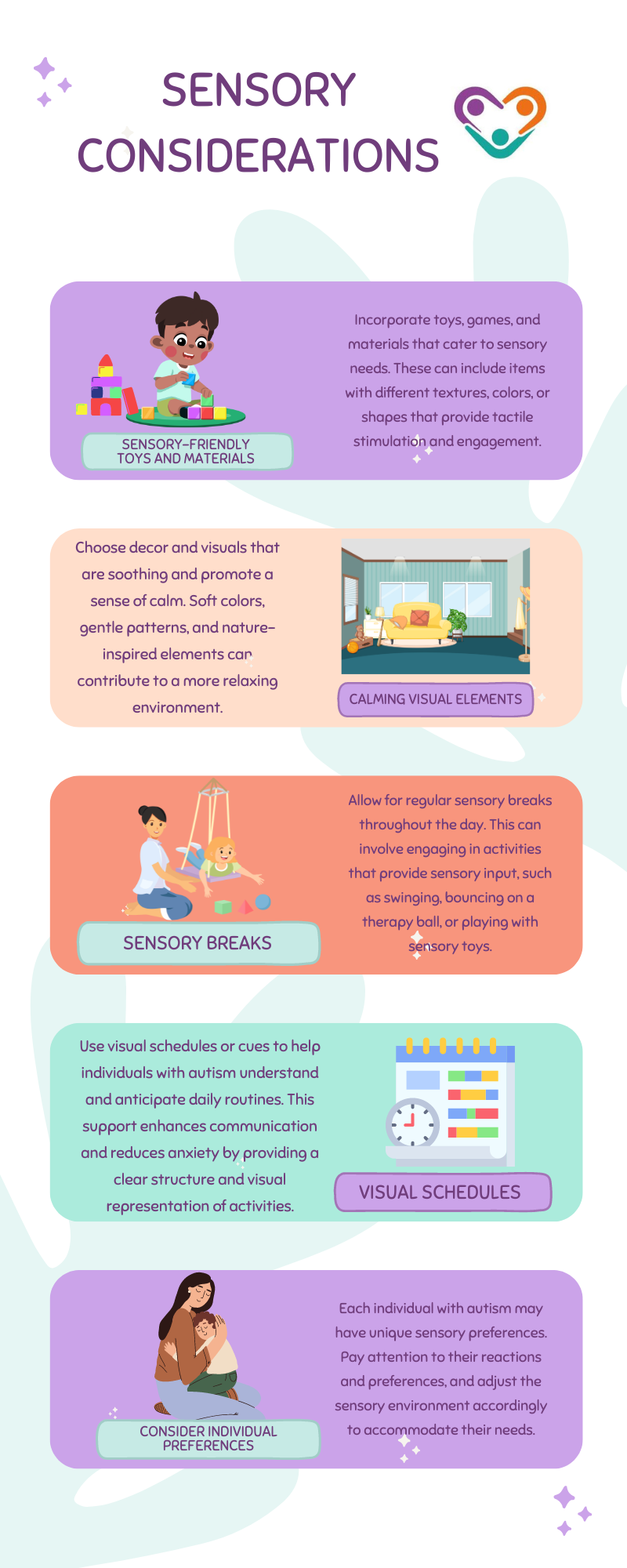Creating a supportive home environment for someone with autism can make a big difference in their daily life. Understanding and meeting their unique needs can help them feel more comfortable and thrive.
In this guide, we’ll walk you through practical tips and strategies to offer the best support for autistic individuals at home.
Creating Routines for Growth
Creating routines within a supportive environment is key to helping individuals with autism grow and thrive. By establishing structured routines, individuals with autism can develop a sense of predictability and stability, which can reduce anxiety and improve overall well-being.
An effective approach is the implementation of Applied Behavior Analysis (ABA) therapy at home. ABA is a highly regarded method for supporting individuals with autism, as it sets clear and measurable goals.
ABA can be learned and applied by parents and caregivers to address various objectives, such as toilet training, self-help skills, communication enhancement, and challenges related to food and eating habits.
In addition to ABA, organizations like the Oxford Center emphasize the importance of individualized paths and journeys for each child with autism. By tailoring routines and interventions to meet the specific needs of the individual, families can create an environment that fosters growth and development.
Sensory Considerations
Parents and caregivers should consider the sensory needs of their autistic children when supporting them at home. After all, children with autism often process sensory information differently from neurotypical individuals, which can lead to certain noises, lights, foods, or clothing causing discomfort or distraction.
To minimize sensory challenges, it is important to identify and address potential triggers that may cause discomfort or distress. Here are some strategies that can help:
- Adjust Lighting: Bright or flickering lights can be overwhelming for individuals with autism. Using softer lighting or dimming the lights in certain areas of the home can create a more calming environment.
- Provide Quiet Spaces: Creating designated quiet spaces where individuals with autism can retreat to when they feel overwhelmed can be beneficial. These spaces should be free from excessive noise and distractions.
- Use Ear Defenders or Headphones: Noise-canceling headphones or ear defenders can help individuals with autism reduce the impact of loud or sudden noises, providing a sense of comfort and security.
- Use Tagless Clothing: Many individuals with autism have sensory sensitivities, particularly to certain textures or tags in clothing. Opting for tagless clothing made from soft materials can help minimize discomfort.
Apart from that, creating a comfortable sensory setting at home is also important. This involves providing an environment that supports sensory needs and promotes a sense of well-being. Here are some considerations for establishing a comfortable sensory setting:

Minimizing sensory challenges and creating a comfortable sensory setting at home allow parents and caregivers to help individuals with autism feel more at ease and supported in their daily lives.
Communication Strategies
Effective communication is essential for individuals with autism to express their needs, connect with others, and navigate daily life. Supporting communication development at home can make a significant impact on a child’s overall well-being and quality of life.
In this section, we will explore two strategies for promoting communication in individuals with autism. These are as follows:
Teaching Communication Methods
Communication challenges are common for individuals with autism, and it is crucial for parents and caregivers to understand that there is often more happening in their thoughts than what is expressed verbally. Teaching various communication methods can help individuals with autism effectively describe their needs and interact with others.
Some effective communication methods for individuals with autism include:
- Using Words: Encouraging the use of words to express thoughts, feelings, and needs.
- Signs: Incorporating sign language to support communication and increase vocabulary.
- Pictures and Communication Boards: Utilizing visual aids such as pictures and communication boards to help individuals with autism communicate their desires or needs.
- Picture Schedules: Creating visual schedules to provide structure and support understanding of daily routines.
- Speech Output Devices: Introducing speech output devices that generate spoken words based on individual inputs.
Utilizing Alternative Communication
Speech therapy plays a significant role in improving communication skills for individuals with autism. Parents can support their child’s speech therapy progress by incorporating exercises and activities at home.
These activities can include:
- Using Words Effectively: Encouraging the use of appropriate vocabulary and sentence formation.
- Expressing Themselves: Helping individuals with autism express their thoughts and emotions through speech or gestures.
- Understanding Appropriate Communication: Assisting individuals with autism to comprehend social cues, non-verbal communication, and the context of different conversations.
Communication strategies for supporting individuals with autism also involve adjusting conversations to their pace, using clear and concise language with a low, firm tone, allowing for pauses, and helping them manage their emotions.
It is important for parents and caregivers to be persistent and empathetic in their communication efforts, aiming to help individuals with autism develop emotional intelligence and effective communication skills.

ABA at Home
The Applied Behavior Analysis (ABA) program acknowledges the importance of consistency and collaboration between professionals and parents in supporting the child’s learning and progress. ABA professionals work closely with parents to provide guidance and training on implementing ABA techniques at home.
By incorporating ABA strategies into the home environment, parents can help reinforce the skills and behaviors targeted during therapy sessions. This consistency between therapy sessions and home life can enhance the child’s understanding and generalization of skills, leading to more effective progress.
ABA at home involves creating a structured and supportive environment that encourages positive behaviors and skill development.
Parents are taught how to implement specific techniques, such as reinforcement strategies and prompting methods, to encourage desired behaviors and discourage challenging behaviors. These techniques can be tailored to address the unique needs and challenges of the individual with autism.
One of the key strengths of ABA is its ability to address specific goals based on the individual’s needs. ABA can be applied to various areas of daily living, including toilet training, self-help skills, communication enhancement, and challenges related to food and eating habits.
By breaking down these goals into smaller, manageable steps, ABA enables individuals with autism to learn and acquire new skills gradually. ABA techniques such as task analysis and prompting are used to teach and reinforce each step of the desired behavior.
The individualized nature of ABA allows for a tailored approach to address the unique challenges and goals of each individual with autism.
Working closely with ABA professionals empowers parents with the knowledge and skills needed to support their child’s development and foster a nurturing environment at home. If you need personalized assistance for your autistic children, Golden Care Therapy provides outstanding ABA therapy in New Jersey, Indiana, Georgia, and New York. To explore how we can help or to schedule a consultation, contact us or book an appointment through our website.



